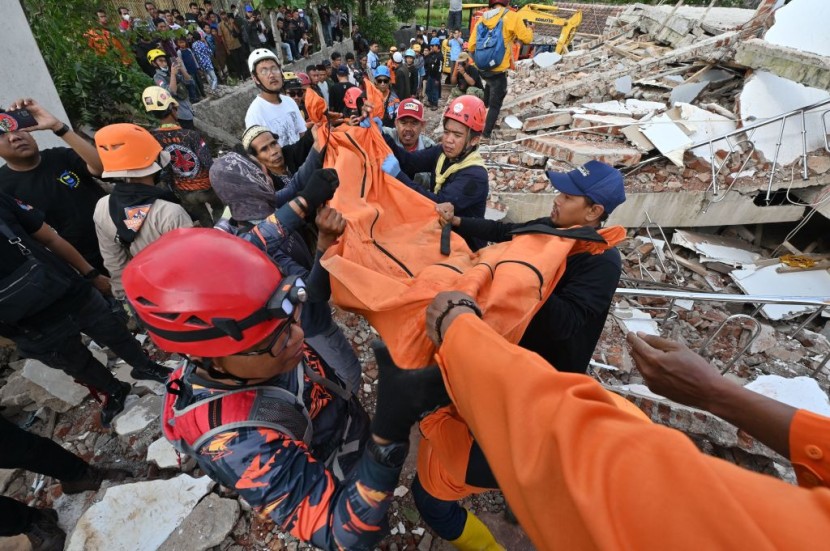
Following an earthquake in West Java, rescuers in Indonesia are searching into a second night in an effort to locate trapped survivors.
The official death toll is 268; many of the victims were children; 151 people are still missing; and there have been over 1,000 injuries.
Indonesia Earthquake Death Toll Jumps to 268
Locating and assisting victims is challenging due to the poor condition of the roads and the extent of the impacted region. Aprizal Mulyadi was trapped after "the room collapsed" while attending class when the earthquake struck.
The 14-year-old said that his "legs were buried in the rubble" but was saved by his friend Zulfikar, who eventually died after becoming trapped himself. According to the National Disaster Mitigation Agency, 22,000 homes sustained damage, and more than 58,000 people had sought refuge in various areas throughout the area.
On Monday, a mountainous area was devastated by a 5.6-magnitude earthquake that resulted in landslides that buried entire villages close to the West Java town of Cianjur. As a result of collapsed walls and roofs, victims were crushed or imprisoned.
Aprizal said, "It all happened so fast." The notion that many of the victims were young individuals was also confirmed by a representative of the National Search and Rescue Agency, BBC News reported. Per PBS, Indonesia is routinely struck by earthquakes, many of which are far more powerful than Monday's, whose magnitude is normally anticipated to only result in little damage.
The tremendous damage, which included caved-in roofs and huge mounds of bricks, concrete, and corrugated metal, was caused by the shallowness of the quake and the lack of appropriate infrastructure, according to experts. One woman said that her home began "shaking like it was dancing" during the earthquake, which was felt most strongly in the isolated, hilly Cianjur area. The Cianjur area is home to almost 2.5 million people, including roughly 175,000 in the major town.
The capital of Jakarta, which is roughly a three-hour drive away, was also shaken by the earthquake, which struck at a depth of 10 kilometers (6.2 miles). High-rise buildings trembled, and some people fled.
According to Suharyanto, the chairman of the National Disaster Mitigation Agency, who goes by one name, not all of the deceased have been located, so it's conceivable that some of the bodies discovered in the wreckage belong to persons who are listed as missing. Endra Atmawidjaja, a representative for the public works and housing department, said that rescue efforts were concentrated on a dozen or more areas in Cianjur where it is still thought that people are trapped.
Read Also : Protest-Hit Iran Intensifies Crackdown in Kurdish Area, Security Forces Kill 12 People Within 24 Hours
Why Indonesia Was Severely Damaged by 5.6 Magnitude Earthquake?
Indonesia is located in the Ring of Fire, a famously active region of the world where the Pacific plate collides with three other tectonic plates in a roughly ring-shaped zone around the Pacific Ocean. Seismic stresses build up at the plate borders when these plates slide past or sink beneath one another, causing earthquakes, volcanic eruptions, and other activities.
A catastrophic tsunami was brought on by a megathrust earthquake of a 9.1 magnitude that occurred in 2004 off the coast of Sumatra in the Indian Ocean. At a subduction zone, when one tectonic plate slides beneath another, this sort of earthquake happens.
BIn contrast, the quake on Monday was a strike-slip earthquake, the same kind that happens along the San Andreas fault in California. A strike-slip earthquake is caused by the grinding together of two tectonic plates, as per The Washington Post via MSN.
Near Jakarta, the capital of Java, USGS scientists located the epicenter of the most recent earthquake. That is one of the reasons it did not cause a tsunami. It impacted at a depth of roughly six miles, according to the experts. That may sound far, but earthquakes may occur hundreds of miles below the surface, and depth can affect how they are perceived above ground. Don Blakeman, an earthquake expert for the USGS, suggested comparing it to tossing a pebble into the middle of a pond.
The rock's impact caused ripples to spread outward, weakening until they eventually disappear. A lot of the damage wrought by an earthquake depends not only on how much shaking takes place but also on how stringent the construction standards are in requiring people to create structures that are earthquake-resistant.
Related Article : 162 Dead in Indonesia Earthquake Today; At Lea
@YouTube
© 2025 HNGN, All rights reserved. Do not reproduce without permission.








